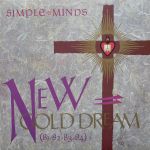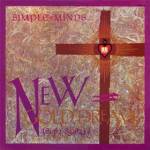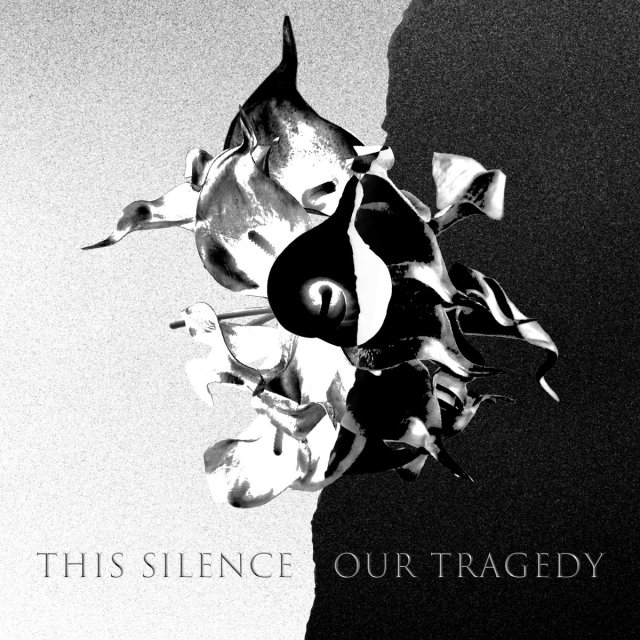 Simple Minds | New Gold Dream [81, 82, 83, 84] – 4
Simple Minds | New Gold Dream [81, 82, 83, 84] – 4
[continued from previous post]
On side two of “New Gold Dream [81, 82, 83, 84],” the title track began with an relentless rhythm box chugging away, but on the US LP, the title track was edited by nearly a minute to 4:46. The track began instead with the song’s distinctive bass rondo echoed with Mike McNeil’s synths – also playing a rondo at a higher pitch. In any case, the song instantly became a Simple Minds benchmark for me. I love the way it represents the furthest mutated strain of Krautrock in its warmest possible guise.
Forbes’ bass rondo stayed in place while the synths surged ahead, giving the song a curious sense of advancement and stasis at the same time. It transfixes my mind whenever I hear it. Ogletree played the drums lightly, as was his wont, with an emphasis on cowbell [strangely enough, already part of Simple Minds’ toolkit from “Sweat In Bullet”]. However, this was the single track on the album featuring two drummers. Mel Gaynor was overdubbed for extra oomph on the track. Producer Peter Walsh recorded the album as live sessions at the behest of Virgin Records, who asked to have this album reflect the band’s live energy. To this end, Walsh recorded multiple takes of each song live to multitrack, and he assembled the optimum takes of each element for the final mix down.
 Amazingly enough, this incredible track was only released as a single in Italy [of course!] in both a 7″ edit [using the US LP edit] and an extended remix of 6:52, which is strangely called the “German remix” by Minds’ fans. This was because the track surfaced outside of Italy only on the original West German pressed CD of this title without fanfare, but I recall the “eureka” moment that ensued when my friend Tom found a copy of this CD in 1985. Talk about buried treasures!
Amazingly enough, this incredible track was only released as a single in Italy [of course!] in both a 7″ edit [using the US LP edit] and an extended remix of 6:52, which is strangely called the “German remix” by Minds’ fans. This was because the track surfaced outside of Italy only on the original West German pressed CD of this title without fanfare, but I recall the “eureka” moment that ensued when my friend Tom found a copy of this CD in 1985. Talk about buried treasures!
“Empires And Dance and Sons And Fascination were so crammed, the sound was so heavy, the way it feels before a storm breaks. When the storm is over, the air is clear and clean. That’s what New Gold Dream felt like.” – Jim Kerr
It is a holy grail of sorts to me to one day hear the full length ten minute take of “New Gold Dream [81,82,83,84]” that was edited down for all subsequent releases. What I would not give for a studio version of this song that lasted that long! One hopes that any NGD mega-box would cough that full-length take up. Kerr’s vocals began pitched low and eventually reaching for the skies as the song progressed. Walsh’s production wrapped the entire band in a shimmering, glistening envelope that emphasized light and air at the expense of grit and shadow. For that reason, it has become almost a self-referential album with few connections to the outside world as it constructed a hermetic seal, cocooning the listener in whorls of dreamlike sound.
The second single from the album was “Glittering Prize;” a delicate and gentle paean of almost monastic devotion to the ideal of romantic love given the lightest and most insouciant setting possible. Forbes’ bassline was a wonder of subdued power and intricacy that remains a paragon of complexity while being nestled within a song that seems as light as a soufflé. The bass tenderly caressed the song in a spirit of good fellowship and used its strength and power to allow the melody to hold itself aloft and take flight. It also sported the coldest intro that any single ever had [just one chord] and gave the band a song to start “on the one” as tightly as any James Brown funk workout while remaining an entirely different beast.
The mood turned more somber when “Hunter And the Hunted” began as built upon a bass line rondo that was progressively overlaid with delicate Mike MacNeil synth lines until it formed a web of subdued passion, gradually fading out as MacNeil occupied all of the space in the intro. Forbes then re-entered the song on fretless bass giving the synth leads a subtle rhythmic impetus that drove the song forward. Jim Kerr sang in his lowest register for the quietly devastating chorus where powerful lyrical imagery like “Kyoto in the snow – heaven’s far away” could not have been painted in a more darkly romantic light.
This track also paid host to the strangest credit to land on a Simple Minds record. None other than Herbie Hancock played the song’s distinctive synth solo that lasted from he song’s middle through to its conclusion. He was recording at Townhouse studios when the band were laying it down and called the man in to see if he would play on it. Not just any jazz keyboardist could have made a berth for himself on a Simple Minds number, but this instance showed that fortune was beaming on the band and their efforts. His low-key injection of jazz DNA resonated within the dark structure that the band had built, making it greater than the sum of its parts.
The one look backward on this album was the album’s introverted closing track, “King Is White & In The Crowd.” It is the album’s one link with the past. It features a minor key melody and hypnotic trance rhythms as it examines a political subtext [the assassination of Anwar Sadat] in a result that would be at home on their third album as much as this one though the hazy, dreamlike production here was nothing like the monolithic sounds of “Empires + Dance.” Not surprisingly, it was one of the first tracks written after wrapping production on “Sons + Fascination.” It strongly radiated the vibe of the previous two albums, albeit within the shimmering context of the band’s present. One last dip into the Krautrock toolkit with its trance rhythms and long, repetitive 7:00 running time for good measure.
I have heard live recordings of this song from a few years later where Forbes’ bassline had undergone a dramatic metamorphosis to become the dominant note of the song in a fashion that I can only describe as the bass riff of god. The heavily flanged monster that dominated the proceedings on recordings like the Irvington broadcast of 1984 are jaw-droppingly astounding in ways that show how dramatically Simple Minds forward progress would be, at least for the next few years. The band were not content to write songs and let them calcify onstage into a rote pantomime. This band were striving to refine, re-imagine, and re-model their history by taking their songs and refining them in the fire of performance like the gold that they were.
With “New Gold Dream [81, 82, 83, 84],” the band had shed their constructivist chrysalis to emerge as iridescent butterflies held aloft on the classic themes of eros and thanatos. Most of the songs examined desire from a wholly Apollonian perspective of Romantic idealization. At most smoldering with an intense passion that only young men seem truly capable of. A few of them, [“Big Sleep” and “King Is White And In The Crowd] investigate death and demise but they maintain a similar distance from the center of these strong emotions. In spite of the intellectual distance that their songs kept from their increasingly less abstract subject matter, they still seemed to be somewhat tentative in their level of commitment. Perhaps for this reason, Jim Kerr called “New Gold Dream [81, 82, 83, 84]” a “coffee-table album” half-dismissively, shortly after its release. Their next album would address this sense of restraint.
Next: …From Shimmer to Sparkle












Side Two of NDG soars on warm jet streams, scaling musical mountains, returning to hover close to the safety of the musical ground they had previously built on, but never really alighting on that same travelled ground.
Derek Forbes bass is the engine on these songs, burning the fuel, perpetuating the bands flight. Mick MacNeil’s synths and Charlie Burchill’s guitar both soar and steer the SM ship from horizon to horizon.
Peter Walsh is really the sixth member of the band. His production style, and overdubbing ability added a complexity and texture that Simple Minds only benefitted from. No track is too long, many end way before the listener is ready to let go of them. The idea that you want to hear more, not feeling a track to be repetitive is a rare success.
The title track is a musical carnival gravitron. It spins and spins, bulling the listener to its edges and holding them tight. But that motion isn’t stationary. Kerr’s vocals and MacNeils synths speed the the spinning top along the edges of the clouds.
Any typical band would either start or end an album side with a triumphant, song like The Glittering Prize, but on an album as deep and rich as NDG, wherever it was placed was going to be just right. It’s an anthem in the sense that it is inescapable, impossible not to get caught up and rejoice in it’s magnetic effect.
Hunter and the Hunted always gives me goosebumps. There’s a really personal, almost religious, romance about the song. Everything about the track sound like it comes from deep within.
While King Is White And In The Crowd, being the first post SAF song they recorded, recalls the angst of SM’s past (and not a small homage to the influence of Talking Heads Fear Of Music), it also builds to a crescendo of intensity which will see them scale new sonic heights in two year’s time. As the song fades, the drum kicks as if it doesn’t want to be silence and will return in full form. It certainly will…
LikeLike
Before I bought my own copy of NGD on record and later on CD, I was taping the album from a friend (yeah, I know). By some mistake I started recording the B-side first without ever noticing.
Even when I bought my own copy on vinyl it never occured to me that the album could start with anything else than the title track and end with “Somebody up there…”.
When I finally listened to my CD version for the first time, I actually thought that THEY messed up the running order and I couldn´t get into that sequence at all!
To this day I have programmed my listening experience in my old, faulty order.
Maybe you should try it someday, I think it makes this fantastic album even better!
Instead of throwing you right away into “Someone, somewhere…” we drift slowly into the dream with the 8 second fade-in of the drum-machine (on the european version) before that spiralling, gyrating powerhouse of a song whirls you away.
My A-side closes with “King is white…” the longest song here with its relatively sudden fade-out after a sprawling, meandering run. That is then perfectly followed by “Someone…” which comes like a wake-up call bringing fresh energy that sets you up for the following hit-after-hit-run.
As Echorich stated above: with a collection of such strong songs, it might be irreverent where they are placed, but I could NEVER get over the idea that this album could start with anything else than the title track. Subsequently the insturmental chill out of “Somebody up there likes you” HAS to be the perfect closer with its long, ethereal fade that sounds like it could directly segue back into the fade-in of “New Gold Dream”, which eternally loops the dream.
Man, they were actually YOUNG GODS with that album and sadly (at least for me) it was all downhill from then on.
“King is white…” as the closing track? Ha, no way!
LikeLike
stellaVista – I completely get it! I can see how that would be a much better sequence for the album. I agree that “King Is White And In The Crowd” is a poor choice for the album coda. Besides, when I first heard Heaven 17’s “Penthouse + Pavement” it was on a cassette that chasinvictoria had made for me of it as soon as it was released, and he had recorded the Penthouse side first, in line with the album’s name. When I later got my own copy, it never seemed quite right hearing the retro sounding, Human League-like material after the forward looking Pavement side, which was in fact the band’s future.
LikeLike
I can see this as well. Especially “Geisha Boys” would make a perfect opener. The only problem would be the infinity groove of “We´re going to live…”, you would never make it to the pavement side.
LikeLike
stellaVista – Great point on the runout groove! Of course, chasinvictoria had recorded the tape and faded it out. Until I bought the vinyl, I had no idea that it was there! The initial UK CD faded “We’re Going To Live For A very Long Time” far too quickly for my tastes. The statement looses a lot when it’s not utterly relentless and a little bit scary. The recent remaster at least runs for a minute or two. Personally, I would fill the remaining time on the CD with the track!
LikeLike
Back in the old days, before these — the End Times, the Monk and I used to make (mostly) sampler cassettes for people. I only made tapes of full albums when the work in question was a Heartbreaking Masterpiece of Staggering Genius (™) that someone I knew needed to hear!
I routinely hear from people for whom I made those sampler cassettes now (cough cough) years later, and they usually tell me how important that cassette was, that they still have it, that they discovered many bands (directly or related artists) through it, or that it really soundtracked an era of their lives. I think cassette samplers sold more albums than advertising, personally …
LikeLike
“I knew he loved me, cause he made me a tape.” (from “Over the border” by Saint Etienne)
LikeLike
That is a great song that celebrates so much of our 80’s youth!!
LikeLike